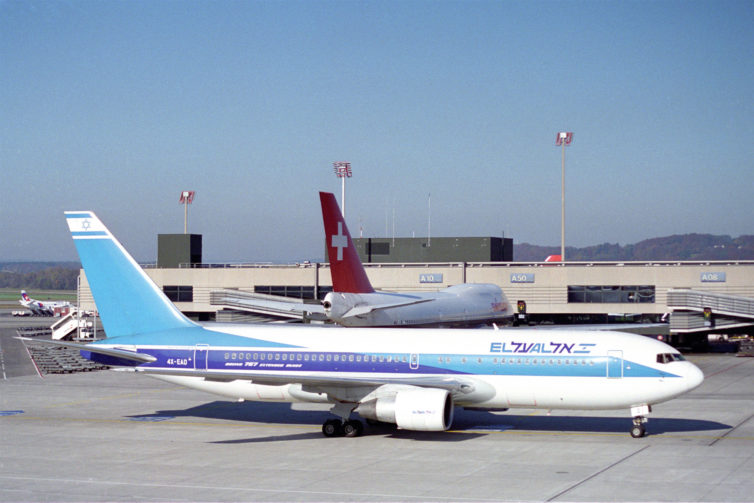
An El Al 767 at Zurich airport – Photo: Aero Icarus | Wikimedia Commons
Ask any self-respecting airline geek which airline was the first to introduce commercial trans-Atlantic twin-engine services, and you’d probably get an answer like TWA, American, or maybe Air Canada. The surprising answer? Plucky little El Al, the fiercely independent but resource-challenged national airline of Israel. How did that happen?
Never shy in taking on a new challenge, El Al has built a reputation on pioneering industry breakthroughs ’“ a non-stop distance record on the JFK-TLV proving flight with a Bristol Britannia in 1957 (5,760 miles). A trans-Atlantic speed record on the 707 JFK-LHR segment in 1970 (7 hours, 57 minutes). The ultimate ’œhigh passenger density’ 747-400 operation in which a staggering 1,122 Ethiopian refugees were safely (if not so comfortably) evacuated from Addis Ababa to Tel Aviv in 1991. And a set of remarkable COVID repatriation flights in 2020.
In 1983, El Al took delivery of the first of four 767-200s from Boeing. The first two airplanes were the standard range models (4,270-mile range). The second two airframes were extended range (ER) variants, equipped with Pratt & Whitney JT9D-7R4E engines, enabling a range of 5,610 miles.
By 1984, the FAA was actively working with several operators to implement new overwater operational approvals for twin-engine operations ’“ what would become known as ETOPS- Extended-range Twin-engine Operational Performance Standards. But the old rule ’“ that the flight had to stay within a 60-minute radius of a suitable landing site was still in effect.
It’s hard to wrap our heads around this today when we can fly 19 hours with up to 330 minutes ETOPS. But the notion of twin-engine oceanic operations was new stuff back then. A lot was unknown. An inflight engine shutdown would make the remaining engine work harder. Could it handle the stress? Could the one remaining generator or hydraulic pump reliably perform? And simply relying on the APU to cold-start at cruise or for the ram air turbine to properly deploy was not sufficient. Alternate airport requirements were more strict and a host of crew-training, equipage, and certification requirements made the very proposition of viable commercial ETOPS operations a daunting task.
What was clear was that the economics of twin-engine operations was quite compelling. The cost savings of operating a 767-200 with 190 passengers compared to a 370-seat 747 on a typical trans-Atlantic route was in the range of 45%. Fuel and crew costs (including the new two-person cockpit of the 767) accounted for the majority of the trip savings.
Having trialed its two ERs on shorter European runs from Tel Aviv, El Al was ready to exploit the 60-minute rule for commercial service from North America. On March 26, 1984, El Al became the first airline to offer commercial ETOPS flights, operating a 767-200ER (4X-EAC) from Montreal to Tel Aviv. The non-stop route, in compliance with the 60-minute rule, took 11 hours and 8 minutes.
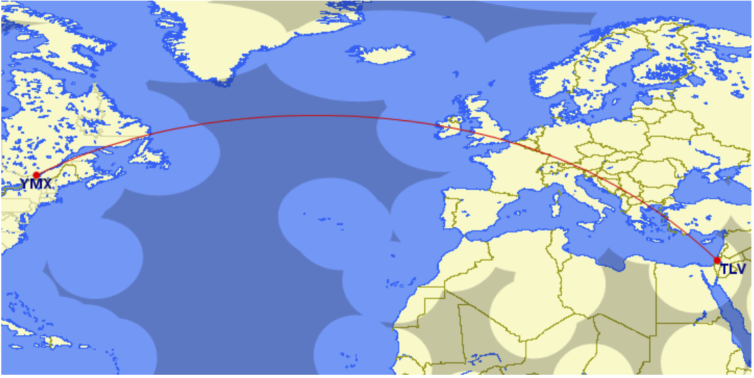
El Al’s first ETOPS flight was from Tel Aviv to Montreal on March 26, 1984 – Image: Great Circle Mapper
Based on the early success of the Montreal route, El Al added more ETOPS flights the next year offering 767ER service on the following routes:
- Tel Aviv ’“ Amsterdam ’“ Chicago ’“ Los Angeles (LAX)
- Tel Aviv ’“ Amsterdam ’“ Montreal
- Tel Aviv — Amsterdam ’“ New York (JFK) ’“ Miami
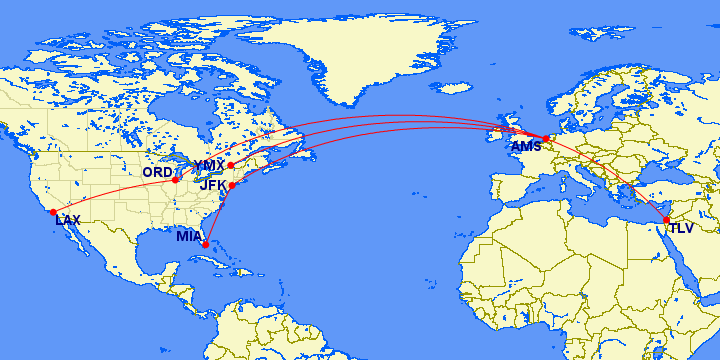
El Al’s early transatlantic routes were groundbreaking – Image: Great Circle Mapper
Ultimately, the airline would achieve 120-minute ETOPS approval, allowing more flexible routings on the North Atlantic runs.
El Al’s achievement was groundbreaking ’“ both technologically and psychologically. There was a lot of resistance to the idea of twin-engine oceanic flights back then ’“ from the International Federation of Airline Pilots (IFALPA) to former FAA Administrator Lynn Helms. Ultimately, technology ’“ and economics ’“ would prevail.
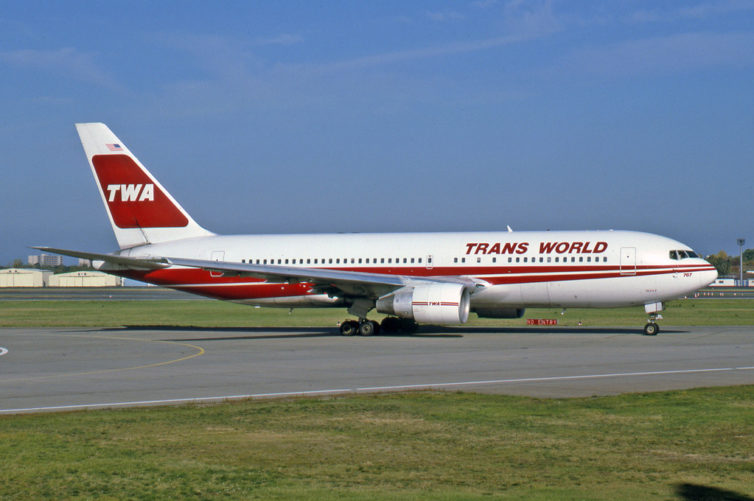
TWA was quick to follow El Al’s ETOPS example – Photo: Ralf Manteufel | Wikimedia Commons
El Al’s exploits were closely monitored by other airlines, eager to cash in on the favorable twin-engine economics. TWA had ten 767s on order at the time, and was working with the FAA to secure 120-minute ETOPS authority, which would allow for more direct routings from its St. Louis hub. TWA launched trans-Atlantic ETOPS flights the following year on its Boston ’“ Paris route and would go on to build a network of 767 routes from St. Louis and New York (JFK) hubs. American and Air Canada were quick to follow. The floodgates were opening.
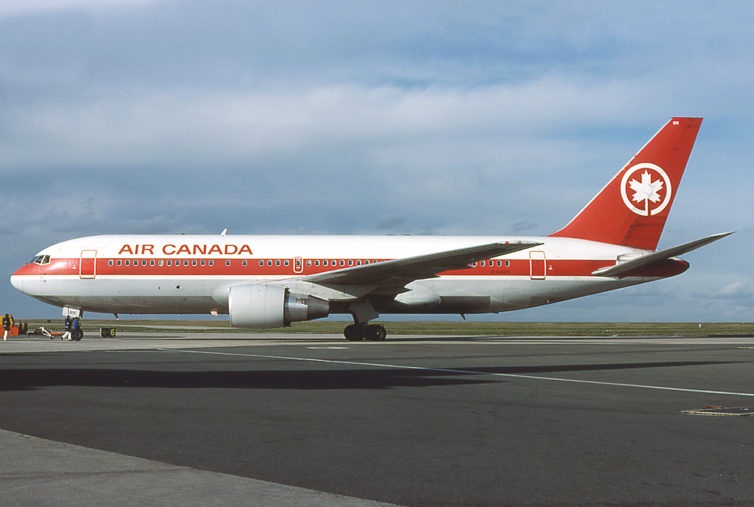
Air Canada quickly sought ETOPS certification for its 767s as well – Photo: Michel Gilliand | Wikimedia Commons
Today, the vast majority of flights across oceans are performed by twin-engine airplanes. Few were the visionaries who could foresee that development in the early 1980s, when the very notion of twins across the ocean was controversial. But the contemporary dominance of twin-engine intercontinental flight came about only through three decades of patient, deliberate development in commercial ETOPS operations ’“ punctuated by the bold exploits of a few early movers. So, next time you board a 787 for Frankfurt or A350 to Hong Kong, you might just tip your hat to that plucky airline from Israel that started it all.
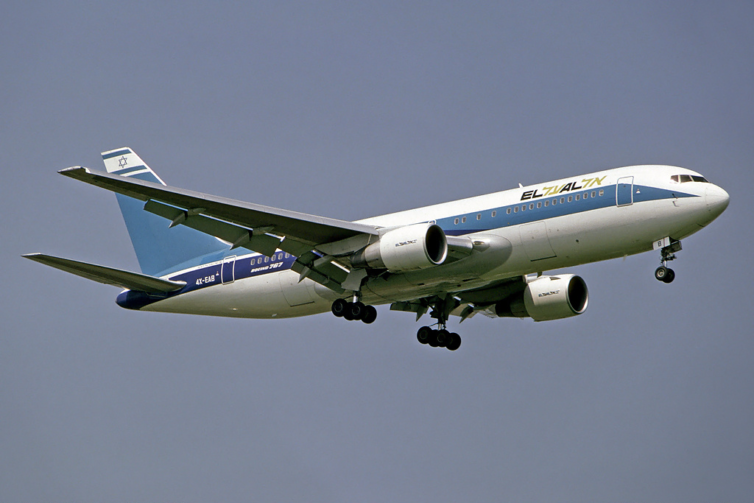
Not gonna lie – it’d be great if El Al would do a heritage livery like this – Photo: Michel Gilliand | Wikimedia Commons
About the Author: Steve Jaffe is founder and editor of airlinestoisrael.com and author of Airspace Closure and Civil Aviation — a Strategic Resource for Airline Managers. His career has spanned all facets of commercial aviation, including marketing and consulting roles at Boeing, the FAA, US Airways, and AVITAS. He remains an avid avgeek (best plane ever — the 757) and is working on indoctrinating the next generation of geeks and geekettes.
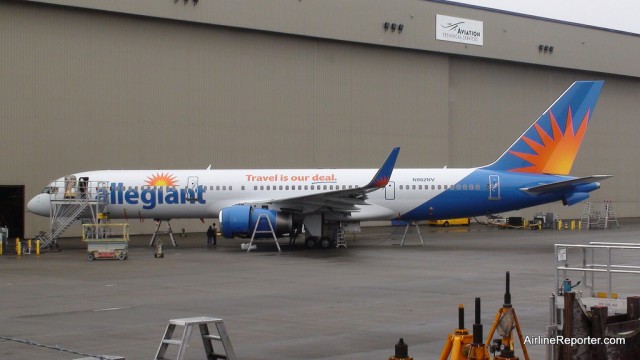
One of Allegiant Air's Boeing 757s (N902NV) while still in Everett, WA.
The journey from rumors that Allegiant Air was to add Boeing 757-200s during the summer 2010 to their fleet to now receiving ETOPS and Flag Carrier Status status from the Federal Aviation Administration has been long.
Last summer, it was a let down for Allegiant, when the FAA gave them authorization to fly the new aircraft type, but they would not give the airline ETOPS certification to fly over the water to Hawaii. Over the past year, Allegiant has been flying a few 757s on routes in the continental US to gain experience. That experience is finally paying off and starting at the end of this month, the airline will start service to Honolulu, followed by Maui in November. Allegiant’s non-stop service plan to Honolulu:
Las Vegas ’“ begins June 29
Fresno, Calif. ’“ begins June 30
Bellingham, Wash. ’“ begins November 15
Monterey, Calif ’“ begins November 16
Eugene, Ore. ’“ begins November 17
Santa Maria, Calif. ’“ begins November 17
Stockton, Calif. ’“ begins November 18
Allegiant will also offer nonstop air service to Maui from:
Bellingham, Wash. ’“ begins November 14
’œThis is an important day for Allegiant,’ Andrew C. Levy, Allegiant Travel Company President, said. ’œObtaining ETOPS and Flag Carrier status not only clears the path for our new service to Hawaii, but also opens up potential international opportunities and will play an important role in our company’s future growth. Our operations team worked long and hard to ensure the completion of this certification and we thank them for their dedication in achieving this important goal.’
Currently, Allegiant operates a fleet of 58 MD-80 aircraft and four Boeing 757-200s. They still have two additional 757s that are being leased. Allegiant plans to put one 757 into service during fourth quarter 2012 and the second first quarter of 2013.
Allegiant is still planning to grow and is looking at other route options. Previously Levy has stated that the airline is looking at the possibility of flying to Canada, Mexico and even South America.
Over the past week I have been receiving many different press releases from Boeing – most of which I wanted to share, but haven’t had the time to give them the attention that they deserve. To make sure that they all get a little attention, I decided to do this round up to touch base on what’s going on with Boeing. There are a few more story lines that I hope to go into a bit more detail over the next few days, but for now…
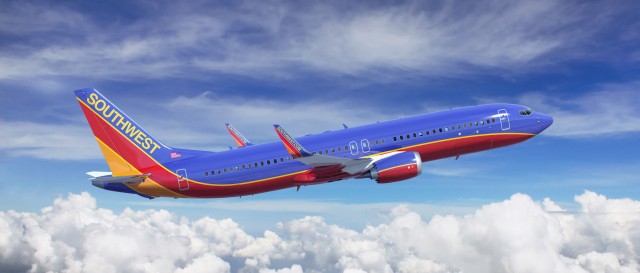
HI RES (click for bigger): Southwest Airlines Boeing 737 MAX 8. Photo by Boeing.
SOUTHWEST AIRLINES BECOMES LAUNCH CUSTOMER FOR THE 737 MAX
On December 13th, Boeing announced that Southwest airlines placed an order for 150 of the 737 MAX and would become the launch customer the new version of the 737.
“Southwest is a special Boeing customer and has been a true partner in the evolution of the 737,” said Boeing Commercial Airplanes President and CEO Jim Albaugh. “Throughout our 40-year relationship, our two companies have collaborated to launch the 737-300, 737-500 and the Next-Generation 737-700 ’“ affirming the 737 as the world’s preferred single-aisle airplane. As launch customer for the 737 MAX, Southwest, Boeing and the 737 continue that legacy.”
The firm order is Boeing’s largest in both dollar value and the number of aircraft ordered.
“Today’s environment demands that we become more fuel efficient and environmentally friendly, and as the launch Customer of the Boeing 737 MAX, we have accomplished both,” said Gary Kelly, Southwest Airlines Chairman, President, and CEO. “We are teaming up with our friends from Boeing to lead the industry in a way that makes both our shareholders and our Customers proud to associate with Southwest Airlines. Today’s announcement will allow us to maintain our position as a low-cost provider in the years ahead.”
VIDEO: Southwest Airlines Boeing 737 Max. Computer generated by Boeing. Thanks to Robert for pointing this out.
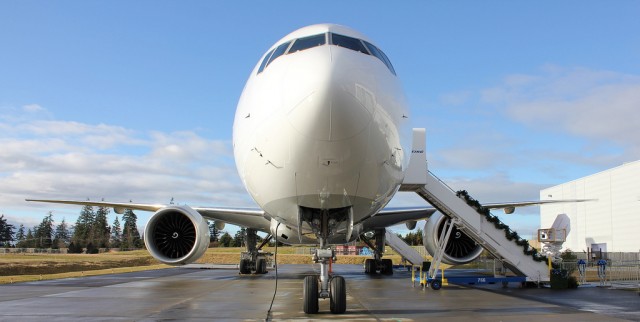
Air New Zealand's first Boeing 777-300ER at Paine Field. Photo by AirlineReporter.com.
BOEING 777 NOW HAS 330-MINUTE ETOPS
On December 12th, Boeing announced that its 777 received approval from the Federal Aviation Administration (FAA) to fly up to 330-minutes away from an alternative airport.
“Boeing twin-engine jets have flown more than 7 million ETOPS flights since 1985, and more than 120 Boeing operators fly more than 50,000 ETOPS flights each month,” said Larry Loftis, vice president and general manager 777 program. “This is the logical continuation of the Boeing philosophy of point-to-point service. Passengers want to minimize their overall travel time. This is one more step in that direction.”
To date, the 777 has flown more than 2 million ETOPS flights since June 1995 and 93% of 777s are flown on ETOPS routes.
“What this means is that the airplane is able to fly a straighter route between the city pairs and that’s good for the environment,” said Capt. David Morgan, chief pilot for Air New Zealand. “Less fuel is burned and less carbon dioxide is emitted into the atmosphere. It’s also good for customers because flights are potentially shorter and passengers could arrive sooner at their destinations.”
CHECKING IN WITH THE DREAMLINER WORLD TOUR
Boeing’s third Dreamliner, ZA003, is taking a six month journey around the world. Its first stop was in Beijing, China with different stops with-in China from December 4th to 11th.
“This great day demonstrates our partnership with China in pursuing aviation excellence,” said Marc Allen, Boeing China president. “Chengfei, Hafei and Shenfei — as exclusive and single-source Boeing suppliers — have made a great contribution to the success of the 787 program, producing the rudder, wing-to-body fairing, and vertical fin leading edge. We want to thank them for their role in making today possible.”
On the 11th, ZA003 flew over to Africa and became the first time a 787 has landed in that continent. From the 11th to the 14th, the 787 hung out in Nairobi and allowed Ethiopian Airline employees the chance to see the new aircraft they should be taking delivery of soon. ZA003 will remain in Africa until the 16th of December before flying to the Middle East with a stop in Doha to visit Qatar Airways.
At this point, Boeing has not announced future destinations, but I would imagine that ZA003 will continue to head west.
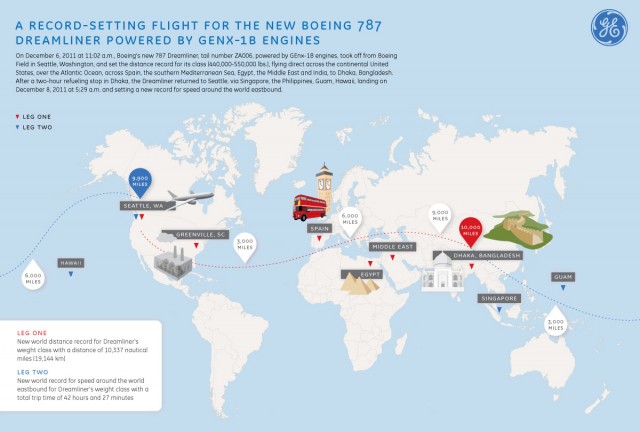
Graphic showing the record breaking Boeing 787 Dreamliner flight. Image is from GE. Click for larger.
THE 787 DREAMLINER BREAKS WORLD RECORDS
While ZA003 is traveling the world, ZA006 went and set some new world records. The 787 Dreamliner recently established two new records for speed and distance for the aircraft’s weight class.
From Boeing’s press release, “The sixth 787, ZA006, powered by General Electric GEnx engines, departed from Boeing Field in Seattle at 11:02 a.m. on Dec. 6 and set the distance record for its class (440,000-550,000 lbs.) with a 10,710 nmi (19,835 km) flight to Dhaka, Bangladesh, with credit for 10,337 nmi (19,144 km). This record had previously been held by the Airbus A330 based on a 9,127 nmi (16,903 km) flight in 2002.”
“Following an approximately two-hour stop for refueling in Dhaka, the airplane returned to Seattle on a 9,734 nmi (18,027 km) flight. The airplane landed at 5:29 a.m. on Dec. 8, setting a new record for speed around the world (eastbound) with a total trip time of 42 hours and 27 minutes. There was no previous around-the-world speed record for this weight class.”
Go Dreamliner go!
OTHER BOEING HEADLINES RECENTLY:
* FedEx announced order for additional 767 and 777 Freighters
* Boeing 747-8 Intercontinental Receives FAA Certification
* Ethihad Airways Orders 10 787-9 Dreamliners
* Boeing to Build New Everett Delivery Center at Paine Field









